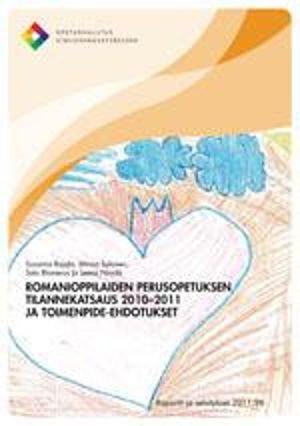Romanioppilaiden perusopetuksen tilannekatsaus 2010-2011 ja toimenpide-ehdotukset
This report reviews the situation of the basic education of Roma pupils in Finland in the school year 2010-2011 and makes proposals to improve the situation. In addition, the report considers the development which has taken place since the previous report on the basic education of Roma pupils, concerning the school year 2000-2001, was published. The report is based on a questionnaire sent to headmasters of basic education establishments as well as interviews with Roma pupils and their guradians and representatives of municipalities.
Concerning the general school performance level of Roma pupils, the situation appears to have improved. In the previous report, headmasters estimated that only 10 % of Roma pupils were doing well in theoretical subjects, whereas now the headmasters estimated that 70 % of Roma pupils were doing at least satisfactorily in school. However, one third of Roma pupils do poorly or adequately in basic education and many Roma pupils repeat a year at some point. Roma parents and carers have a better impression than headmasters of how the children are doing at school. Workers of Roma background are useful promoters of tolerance and supporters of Roma pupils.
Cooperation between schools and Roma homes works well, which is a positive development, as functioning cooperation makes it easier to intervene in the challenges Roma pupils face in school. Roma parents and carers value cooperation with teachers and other educational staff.
Roma pupils are rarely targets of open and systematic exclusion or bullying. Roma pupils also rarely act as bullies. Headmasters, Roma parents and carers and Roma pupils all felt that cases of bullying which come to light are usually addressed, and that the intervention usually helps. When Roma pupils are bullied, it is most often ethnic name-calling. However, not all bullying is necessarily directly due to the pupil’s Roma background.
Regarding absences, headmasters said that Roma pupils’ frequent absences often result in problems. The situation was much the same ten years earlier. What is alarming is that not all Roma parents, carers and pupils seem to take the matter seriously. Roma pupils’ absences are often due to illness, travel or sickness of a family member. In the school year 2010-2011, a total of 12 % of all Roma pupils changed school, and almost 5 % dropped out altogether. The percentages are the same as in the school year 2000-2001. Roma pupils with many problems in their schooling, or who are in danger of dropping out, should be offered more effective forms of support at an early stage.
An increasing number of Roma pupils complete their basic education today, and the development since the release of the previous report has been positive. Nevertheless, too many of them still fail to gain their basic education certificate. Too few still seek further education, at least immediately on leaving comprehensive school. The reason is often the early assumption of adult status and the rapid starting of a family, as well as a lack of information and encouragement.
Teaching of the Romani language has more than doubled since the previous report came out. Regional differences exist: in Southern Finland, a quarter of Roma pupils were taught Romani, while figures in other parts of Finland were clearly lower. Additionally, almost two thirds of the headmasters reported that their school staff had familiarised themselves with Romani culture. The level of familiarisation was best in municipalities involved in developing Roma pupils’ basic education. Familiarisation increases acceptance and tolerance at school.

